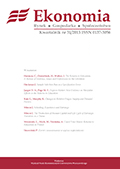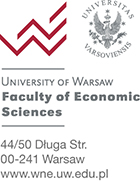Issue number: 46
In this issue:
Innovation Intensity as a Driver of Firm's Internationalization Intensity: Evidence for Poland
T. Brodzicki
ABSTRACT |
PDF
The aim of the article is an empirical identification of the relationship between the extent of innovation and the extent of internation- alization in the cross-sectional sample of firms from Poland. Firstly, both extents of innovation and of internationalization are defined, calculated and analyzed separately and then jointly. The mean changing characteristics of companies along two dimensions are depicted. Secondly, the nexus between internationalization and innovation is econometrically analyzed with the use of OLS, MNL, OL, and IV models. Thirdly, the role of both in the likelihood of firm-exports is assessed in a logit model.
The obtained results are in line with the postulates of the firm heterogeneity theory. Productivity seems to be a principal driver of firm exports and firm internationalization. Positive correlation between innovation and internationalization extents is robust with the majority of firm’s inferior performance in both dimensions and, in particular, in comparison to the Western European counterparts. The joint distribution along the two analyzed dimensions shows a pyramidal structure with a peak at low levels of internationalization and innovation. There is some support for the causality going from innovation to internationalization. However, more research is necessary for a panel setting to verify this statement thoroughly.
Regional Variation in the Public Sector Wage Premium in Poland
G. Grotkowska
ABSTRACT |
PDF
There are a number of reasons, related to both the supply and demand side of the labour market, for which the public sector employment wage premium may vary spatially. This variation may affect the efficiency of public services provision, private investment and the equilibrium of regional labour markets. The aim of this study is to assess the scale of regional variation in Polish public-private wage differentials. In this paper, we use the individual dataset from the 2012 Structure of Earnings by Occupation (SEO) survey carried out by the CSO and the propensity score matching method, supplemented by quintile regression, to analyse regional differences in public- private wage differentials. The results reveal that in Poland, the public sector premium is highest in the least economically developed regions. Moreover, it significantly varies between regions across the wage distribution. The volatility of the premium may be to some extent explained by the structure of regional economies and by the development of the private sector in particular.
Linear and Nonlinear Dynamics of Housing Price in Turkey
H. Karamelikli
ABSTRACT |
PDF
Housing sector have an important size in economic activities of Turkey. This sector could absorb an important size of skilled and unskilled unemployed. Furthermore, decreasing rents would cause an increase in household savings because of lightening their basic expenditures. Therefore, having knowledge about the dynamics of housing prices is very crucial for economic policymakers. In this paper, the dynamics between house prices and macroeconomic variables including inflation, interest rate, unemployment and real domestic product are studied. Despite the well-known fact that macroeconomic variables possess asymmetric and nonlinear features, many studies about the dynamics of housing prices has been tested only within a linear framework. Therefore, in this paper non-linear autoregressive distributed lag (NARDL) model is used to explore asymmetrical relations in the long-run. Despite to most researches in this field, the effect of interest rate found with a negative sign. Negative effect of both nominal interest rate and inflation on housing prices alongside of greater impact of inflation in comparison with nominal interest rate, would cause the long-run coefficient of real interest rate be positive. Forethought can explain of the positive relation of the unemployment rate and housing prices.
When Does the Integration of Mitigation and Adaptation in the Land Use Sector Actually Makes Sense?
M. López Ramírez
ABSTRACT |
PDF
The phenomenon of climate change is addressed through two main strategies: mitigation and adaptation. It is broadly recognized that both strategies are interrelated, yet in the land use sector this connection is particularly strong. In fact, the mentioned sector is one of the most promising areas to combine mitigation and adaptation into a single intervention. In spite of its potential, in practice mitigation and adaptation are still treated as two different policy instruments. Concerns about efficiency have emerged as a result of such a dichotomy. However, how to manage an integrated implementation of mitigation and adaptation is still poorly understood. In this research paper, enabling conditions for an enhanced policy outcome in the land use sector were studied. Specifically, a dynamic optimization problem based on the concept of forest transition – the process of changes in forest cover over time as a country or region develops in social and economic terms – was suggested and solved. Forest transition was used to define initial value problems. After that, steady states were characterized for an unregulated economy and different policy configurations. The results show that partial policy interventions (only adaptation or only mitigation) improved the unregulated economy situation but delivered sub-optimal land allocation. It is only under an integrated implementation that optimality can be restored.
The Impact of Monetary Policy and Agent Heterogeneity on Firm Financing Structure: Evidence from the USA
A. Malinowska
ABSTRACT |
PDF
Using panel modelling and firm-level data for 222 US listed companies I investigate how changes in monetary policy approximated by the three-month US LIBOR interest rate and its combined effect with firm-specific characteristics influenced firms’ financing decisions and their liability structure during the period 2005−2014. Reported findings suggest that despite the Zero Lower Bound on the Federal Funds Rate, the three-month US LIBOR has retained its impact on firm total debt, long-term bank debt and short-term trade credit. Monetary policy changes were found to have affected firm’s liability structure, especially through parameters such as size, collateral and profitability.
Educational Mismatches and Earnings in Poland: Are Graduates Penalised for Being Overeducated?
L. Wincenciak
ABSTRACT |
PDF
Qualification mismatch is defined as the difference between the level of qualifications held by employees and those required by the type of work they do. Basing on Kiker et al. (1997), a measure of overeducation and undereducation is proposed on the basis of the ISCO 08 classification of occupations. The dominant education level is determined for a given occupation’s 3-digit group on the basis of the distribution of education levels for employees in that occupation. Each individual having exactly the dominant level of education is considered well-matched. Those with higher levels of education are considered overeducated, those with lower levels − undereducated. An extended Mincer wage regression model with Heckman correction for non-random selection is estimated, using LFS data for Poland for the second quarter of 2013. Significant wage penalties are found in cases of overeducation status, along with positive wage premia for being undereducated, this confirming findings to be noted in the literature of other countries. Applying an approach after Duncan and Hoffman (1981), I find significant positive returns to years of overschooling and negative for underschooling. Young participants on the labour market (graduates) are less penalised for being overeducated, which suggests their overeducation is not necessarily a manifestation of lower ability.

